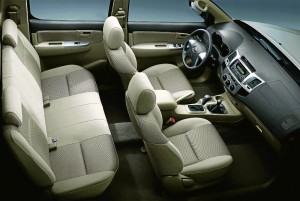Toyota’s Hilux pick-up has a long, iconic history attached to it. The BBC Top Gear’s presenters James May, Richard Hammond and Jeremy Clarkson once called it “the toughest car ever made, able to withstand the end of the world, and just about everything else aside from that.” It is so tough in fact that in most war-torn countries, the Hilux is hard to come by, hoarded by rebels and guerillas who needed a platform to bolt their 50-caliber machine gun or other heavy artillery. Now that is tough.
Here in the Philippines, the Hilux’s toughest challenge is pleasing the Filipino palette for all things tough, yet being easy on your body after a long day at the office, with enough space for their barkada to go have a night out on town, refinement on long drives with family and friends, creature comforts such as MP3 connectivity, a tight turning radius in mall parking spaces, miserly fuel consumption, the list goes on. All while being a truly credible, go-anywhere 4×4 vehicle that exudes power and confidence in any driving condition, be it on or off the road, under heavy load, or driving solo.
So the refreshed Hilux is upon us, and Toyota has made some improvements, mostly in the exterior, but are the changes only skin deep?
Most prominent of all is the new front end treatment which mimics an LC200 Toyota Land Cruiser, the Hilux’s big, brash brother. Cynics, particularly people with the actual LC200 Land Cruiser snicker at Toyota’s decision. Cheesy, or cheap marketing trick to enhance an aura of premium-ness on an otherwise agricultural vehicle? Personally, I think it’s a lot better than the previous face.
New design 17-inch alloy wheels with all-terrain Bridgestone tires rounds out the outside improvements. Inside, the fabric interior gets darker, the dashboard and particularly the HVAC controls are new as well as the multi-function steering wheel which houses audio as well as Bluetooth phone integration controls. Bluetooth phone connectivity on your pick-up truck? This shows where the pick-up market is going to. Hard to fault since post-Ondoy, everyone seems to want a raised vehicle to clear flashfloods. Everyone includes people who previously would never have considered a pick-up, city dwellers and urban racers.
But how is the revised Hilux to drive? In a word, surprisingly smooth, in-city. The ride is less bouncy than I remember, having owned the first iteration of the current Hilux back in 2006. It also has become far more refined, the brakes seem more powerful as well, the steering seems to have gotten lighter despite wearing bigger 17-inch wheels, and surprisingly, a tweak on the drive-by-wire system means that the Hilux is surprisingly much more responsive, much more enjoyable to drive than before. In this manual 2WD 2.5 G variant which shares the 4WD 3.0 G’s height and looks, I had fun blasting up and down the SLEX on an impromptu midnight fun-drive of my own, being too tired to do anything more productive, and too restless to just go home and sleep. But therein lies the trade-off for smooth, in-city driving. Out on highway speeds, the Hilux has surprisingly poor high-speed damping. I have a back-problem, and while the Hilux’s well-sculpted seats do much to comfort my back, the suspension simply gets overwhelmed once you reach speeds of 120kph and above, the entire Hilux oscillating quite violently if the surface is less than baby-bottom smooth. The oscillations feel steady and consistent but very tiring, and on my back, a real struggle as my spine soaks up the load from the constant movements. It feels stable nonetheless, but does require more concentration and focus. Perhaps if the suspension had settled in (it only had 300 kilometers on the odometer when it arrived at my door), the ride will improve, or when there’s payload in the huge truck bed.
The engine, a 2.5 D4D with turbocharger sans intercooler, also struggles past 130 kph with only 101PS and 260 Newton-meters of torque. The 4WD 3.0 is, of course, something else.
While we all shouldn’t be speeding, it is always good to have a modicum of extra power primarily for overtaking, especially on two-lane highways, and when towing or hauling cargo. Thankfully the slick-shifting 5-speed manual’s shift action has been tightened up from the last model I drove which means rowing through the gears to get the most out of the engine is easier. Keeping the engine in its sweet spot at any gear, on any engine speed is the trick to maximizing the limited power, between 1500-2500rpm.
Coming home from Santa Rosa, I slowed down to appreciate just how roomy and airy the interior is, compared to other pick-ups, and enjoy an audio system far better than our previous Hilux. The Hilux feels more luxurious, more airy, and consequently more elegant than its chief rivals, and the dash architecture, despite feeling rather unadventurous, feels very well made, with the HVAC and audio system well-laid out, very intuitive and easy to familiarize oneself. And that is the biggest reason why the Hilux will sell well. Other pick-ups may be more capable off-road, or offer greater value for money, or simply offer more toys. But none deliver the same level of comfort, class and space (the bed is huge, and the interior space is 2nd best overall in class but with roomier front seats and a taller roof) as the Hilux.
Cynics and fans cried foul when Toyota did not include a variable geometry turbocharger into the facelifted Hilux, or introduce a 5-speed automatic (in other markets apparently these two items are available on the Hilux). However, if you focus on just how good the Hilux is, rather than nit-pick on what it doesn’t have compared to the competition, you’ll realize you’re not missing much at all.
Expensive, but that’s the price of luxury.



